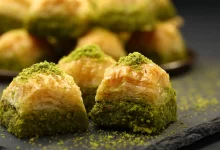Turkish ice cream
Turkish Ice Cream: A Delightful Culinary Tradition

Turkish Ice Cream: A Delightful Culinary Tradition
Turkish ice cream, known locally as “dondurma,” holds a special place in the hearts of locals and visitors alike. With its unique texture, delightful flavors, and entertaining presentation, Turkish ice cream offers a memorable culinary experience that has been enjoyed for centuries. This article delves into the fascinating world of Turkish ice cream, exploring its history, ingredients, production methods, cultural significance, and much more.
Origins and History of Turkish Ice Cream
Turkish ice cream has a rich history that dates back centuries. While the exact origins are somewhat unclear, historical records suggest that ice cream-like desserts were enjoyed in the region as far back as the 16th century. The Ottomans are credited with popularizing the treat and introducing it to the masses during their expansive reign.

Ingredients and Flavor Varieties of Turkish Ice Cream
One of the distinguishing features of Turkish ice cream is its unique ingredients and flavor varieties. Traditional Turkish ice cream is made from milk, sugar, salep (a flour made from wild orchid tubers), and mastic resin. This combination gives Turkish ice cream its characteristic chewy texture and subtle floral aroma.
How to make Turkish Ice Cream
Making Turkish ice cream at home is a delightful culinary adventure that allows you to savor this beloved treat’s unique flavors and textures. While traditional Turkish ice cream requires unique ingredients like salep and mastic resin, here’s a simplified recipe that captures the essence of Turkish ice cream using more readily available ingredients:
Ingredients:
– 2 cups whole milk
– 1 cup heavy cream
– 3/4 cup granulated sugar
– 2 tablespoons cornstarch
– 1 teaspoon vanilla extract
– Optional: ground mastic gum or mastic extract for flavor (available at specialty stores)

Instructions:
1. Heat the Milk and Cream:
– Mix the whole milk and heavy cream over medium heat in a saucepan.
– Heat the mixture until it begins to simmer, but do not let it boil.
2. Mix the Sugar and Cornstarch:
– Whisk the granulated sugar and cornstarch in a separate bowl until well combined.
3. Add the Sugar Mixture:
– Slowly pour the sugar and cornstarch mixture into the saucepan with the milk and cream, whisking constantly to prevent lumps from forming.
4. Thicken the Mixture:
– Continue to cook the mixture over medium heat, stirring constantly, until it thickens to a custard-like consistency. This may take about 10-15 minutes.
5. Flavoring (Optional):
– If using mastic gum or mastic extract for flavor, add it to the mixture and the vanilla extract. Stir until the flavorings are well incorporated.
6. Cool the Mixture:
– Once the mixture has thickened, remove it from the heat and let it cool to room temperature.
7. Churn the Ice Cream:
– Once the mixture has cooled, transfer it to an ice cream maker and churn according to the manufacturer’s instructions until it reaches a soft-serve consistency.
8. Freeze the Ice Cream:
– Transfer the churned ice cream to a freezer-safe container and cover it with plastic wrap or a lid.
– Freeze the ice cream for at least 4 hours or until it is firm and set.
9. Serve and Enjoy:
– Once the ice cream has frozen, scoop it into bowls or cones and serve immediately.
– Garnish with your favorite toppings, such as chopped nuts, chocolate sauce, or fresh fruit, if desired.
– Enjoy the homemade Turkish ice cream with friends and family, savoring its creamy texture and delicious flavor.
Note: While this recipe offers a simplified version of Turkish ice cream, traditional Turkish ice cream may require additional ingredients like salep and mastic resin for its characteristic chewy texture and subtle flavor. These ingredients can be more challenging and may require a trip to a specialty store or online purchase.
Entertainment Factor: The Dondurma Show
One of the most entertaining aspects of enjoying Turkish ice cream is the performance that accompanies its serving. Ice cream vendors, known as “dondurmacı,” are renowned for their playful antics and skillful manipulation of the elastic dessert. With a quick sleight of hand and a few playful tricks, they entertain customers by teasingly withholding the ice cream cone before finally handing it over with a flourish.
Cultural Significance
Turkish ice cream holds deep cultural significance in Turkey and beyond. It is often associated with special occasions, celebrations, and leisurely outings with friends and family. In addition to its culinary appeal, Turkish ice cream has become a symbol of Turkish hospitality and tradition, making it a must-try experience for visitors to the country.

Regional Variations and Specialties
While traditional Turkish ice cream remains popular throughout the country, different regions may have variations and specialties. For example, in the southeastern city of Gaziantep, renowned for its culinary heritage, you’ll find “Maras ice cream,” a type of Turkish ice cream famous for its rich flavor and dense texture.
Modern Innovations and Global Influence
Turkish ice cream has undergone modern innovations and adaptations in recent years to cater to evolving tastes and preferences. From innovative flavor combinations to vegan-friendly options, ice cream makers continue to push the boundaries while staying true to the essence of this beloved treat. Turkish ice cream has also gained popularity globally, with specialty shops and vendors offering their unique creations to eager customers worldwide.
Conclusion: A Sweet Symphony of Flavor and Tradition
In conclusion, Turkish ice cream is more than just a frozen dessert; it is a delightful symphony of flavor, texture, and tradition. Whether enjoyed on a bustling street corner in Istanbul or in the comfort of your home, Turkish ice cream never fails to captivate the senses and leave a lasting impression. So, the next time you find yourself in Turkey or come across a Turkish ice cream vendor in your neighborhood, indulge in this timeless treat and experience the magic.











